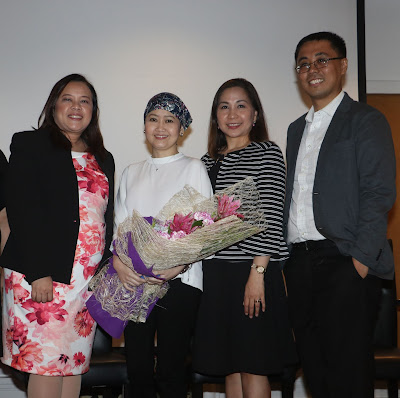Not alone: PH lung cancer community inspires hope in the face of disease
Breakthrough lung cancer pill Osimertinib shows promise at stopping disease progression and improving patient survival
The fight against lung cancer doesn’t have to be a solo battle.
To help Filipino patients and their loved ones rise above this challenging condition, biopharmaceutical company AstraZeneca has partnered with the Philippine Society of Medical Oncology (PSMO), along with local support groups such as the Cancer Coalition Philippines (CCP), and the Philippine Alliance of Patient Organizations (PAPO) to launch LVNG With Lung Cancer, an online resource portal for patients across all stages of the disease.
From left: Dr. Mary Claire Vega-Soliman, President of the Philippine Society of Medical Oncology and Head of the Tumor Clinic of East Avenue Medical Center; Carla Comendador Britanico, a patient living with Stage IV lung cancer for more than 6 years; Dr. Ma. Luisa T. Abesamis-Tiambeng, Director of the Cancer Center at the Cardinal Santos Medical Center; and Dr. Paolo dela Rosa, Medical Advisor and Medical Oncologist at AstraZeneca Philippines.
“Being diagnosed with lung cancer can make patients feel anxious and hopeless, which is why support is vital,” explains Dr. Donald Ray Josue, Medical Affairs Head of AstraZeneca Philippines. “LVNG With provides support by forming a community of patients and their loved ones so they can inspire one another and exchange helpful information about their treatment. Through the network, patients may realize that while lung cancer is not yet curable, it is very treatable. There’s still so much more for them to look forward to in their lives.”
Struggling with stigma
Lung cancer is the top cancer killer worldwide, with 2.09 million incidences and 1.76 million fatalities this year alone according to the GLOBOCAN 2018 report by the International Agency for Research on Cancer (IARC).[1] But while a majority of lung cancer deaths involve tobacco use,[2] non-smokers are also at serious risk.
“‘Are you a smoker?’ Many lung cancer patients get this question, but the truth is, different factors cause the disease,” said Dr. Denky Shoji Dela Rosa, a medical oncologist from the University of the East Ramon Magsaysay Memorial Medical Center and St. Luke’s Medical Center . “Lack of awareness has been a source of stigma because people often put the blame on the individual. This makes it difficult for lung cancer patients to find support and form communities.”
A 2015 study on the European Respiratory Journal notes that about 25 percent of lung cancer incidences are not linked to smoking, and that the rate of never-smokers diagnosed with the disease has been increasing.[3] The American Cancer Society identifies several causes, such as exposure to second-hand smoke, diesel exhaust, asbestos, radioactive radon gas, and chemicals released by burning coal products.
Adding to the stigma, new patients tend to think that their illness is a hopeless case. This leaves them with a sense of isolation that worsens their anxiety over their diagnosis.
LVNG With addresses these stigmas by dispelling myths that prevent lung cancer patients from seeking proper treatment and seeing hope in their condition. The community also empowers patients with information that enable them to reach out to medical professionals so they can learn more about treatment options.
Dr. Mary Claire Soliman, president of the Philippine Society of Medical Oncology and member of Cancer Coalition Philippines also emphasizes that, “Standard evidence-based medicine is the way to go in treatment. I understand how the promise of alternative medicines (‘natural”, “herbal” or “nutraceutical medicine”) may be tempting, especially with their claims that they do not have side effects. The fact of the matter is that there is very little evidence to support these claims.
A recently published study by Skyler B Johnson at the Journal of the National Cancer Institute this January 2018 revealed that patients who initially chose alternative medicine over conventional lung cancer treatment had a more than twofold increase
risk of dying. At the end of the day, alternative treatments should not replace standard evidence-based medicine.”
Breakthrough treatment
Chemotherapy—or the use of drugs to kill and stunt malignant tumors—is usually thought of as the only treatment for cancer. “The fact is, various options are now available depending on the patient’s diagnosis, preference, and recommendations from the healthcare team. Among these include surgery to remove affected lung tissues, radiation therapy that use high doses of radiation to destroy cancer cells, and targeted drug therapy.”, Dr. Maria Luisa Abesamis-Tiambeng of Cardinal Santos Medical Center emphasized.
Targeted drug therapy may be recommended based on biopsy findings. Through biomarker testing, the biopsy can reveal genetic mutations in cancer.





No comments:
Post a Comment